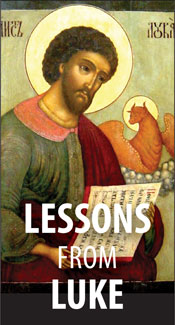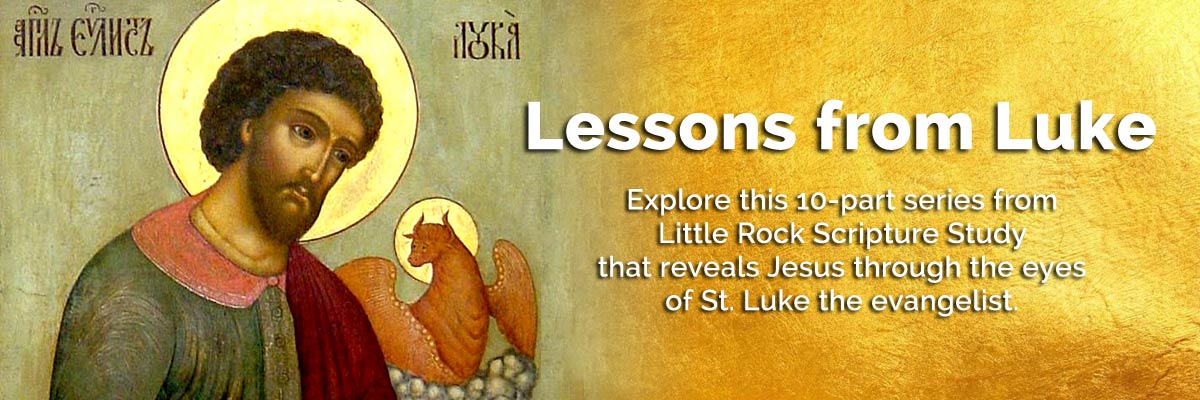Official Website of the
Catholic Diocese of Little Rock
Luke takes us on a journey with Jesus
Published: March 9, 2019
This is the second column in a 10-part series.
By Cackie Upchurch
Director of Little Rock Scripture Study
Every Gospel was written in hindsight, with the end of the story happening before a word was recorded. The death and resurrection of Jesus, and the Spirit-led missionary experience of the early believers, eventually gave birth to the Gospel accounts. The story of Jesus only became clear as the disciples reflected on it after he was raised, as they shared the stories in oral form, honing their skills as sacred storytellers.
 Luke left his imprint on the Gospel that bears his name, and on a second volume, the Acts of the Apostles. A feature that runs throughout both books is that of the journey. The Gospel takes us from the region of Galilee to the city of Jerusalem. Acts resumes the story in Jerusalem and takes readers to “the ends of the earth” (Acts 1:8). The physical journey of Jesus and of his first-generation disciples opens up the landscape for readers to discover other journeys in the biblical text and in our own lives.
Luke left his imprint on the Gospel that bears his name, and on a second volume, the Acts of the Apostles. A feature that runs throughout both books is that of the journey. The Gospel takes us from the region of Galilee to the city of Jerusalem. Acts resumes the story in Jerusalem and takes readers to “the ends of the earth” (Acts 1:8). The physical journey of Jesus and of his first-generation disciples opens up the landscape for readers to discover other journeys in the biblical text and in our own lives.
Luke builds into that larger journey framework a number of smaller and yet significant journeys. Just a few months into her pregnancy, Mary travels from Nazareth to Ein Kerem to visit her older relative Elizabeth (1:39-45). A little later, Mary and Joseph will take their son to the temple in Jerusalem for consecration (2:22-38). And when he is a few years older, Jesus will again travel with his parents to Jerusalem to celebrate the Passover (2:41-52) among descendants of the twelve tribes of Israel who escaped from Egypt centuries earlier.
These physical journeys in the early life of Jesus are also spiritual journeys. Jesus’ parents grow in their understanding of their son’s identity. Those who receive the travelers — Elizabeth, Simeon and Anna, and the temple teachers — help us begin to appreciate Jesus’ role in salvation history, accompanied by centuries of expectation and hope.
The journey motif continues as we see Jesus moving from town to town, inviting his disciples to leave behind their typical routines and see the world through his eyes. They witness that Jesus not only heals physical ailments but heals relationships. Each healing is a journey from brokenness to wholeness. A leper or a woman who is hemorrhaging would have been shunned; their healings allow them to reenter their communities.
Jesus reveals God’s goodness in each small encounter, and in larger sweeps of time and place. He takes Peter, John, and James to a high mountain where the vastness of the land is obvious. But an even larger horizon is revealed as Jesus is transfigured (9:28-36). The disciples hear God’s voice identify Jesus as his chosen Son, commanding them to listen to him. They experience a glimpse of the glory that will be revealed in the fullness of time, but they must also journey back down to the rhythms of daily life.
The final chapters of Luke bring Jesus from the towns and villages around Galilee to the heart of the capital city of Jerusalem. The journey of about 90 miles is punctuated by countless encounters with people in need and numerous opportunities to teach. It is a journey that forms his followers and puts him in opposition with those in power.
Within the city itself, there are three key journeys for Jesus: his entry into Jerusalem on a colt that is marked by praise and shouts of triumph (19:28-40); his journey in chains from the garden of Gethsemane to the Sanhedrin (22:47-71), then to Pilate, the Roman Prefect of Judea (23:1-5), and finally to King Herod, where he was sentenced to death (23:6-25); and his final journey through the streets of Jerusalem as he carried the cross on which he would die (23:26-32).
Surely, as Peter, John, and James view Jesus on the cross ? stripped, beaten, and dead ? they ponder their former journey up the Mount of Transfiguration. They might wonder again about his identity, and about the meaning of discipleship. One answer to their questions may be found in the story of two disciples who travel to Emmaus after Jesus’ death (24:13-35). The stranger who joins the two is present to their sorrow and confusion, warming their hearts as he responds to their questions and offers them insight. It is in the journey that Jesus prepares them to recognize that he is alive and that he will empower them to his mission.
Study Questions
- When has a journey of some kind also been a time of new insight about yourself, or your relationship with God or with others?
- The journey of Jesus toward Jerusalem was more than a physical movement from one place to another. It was also a spiritual journey. How would you describe what happened within him as he made his way toward his destiny?
- Read the story of the disciples who journeyed to Emmaus (Luke 24:13-35). How did Jesus prepare his followers to recognize him? How did their recognition lead to a greater commitment as followers of Christ?
- Do you think of your spiritual life as a journey? If so, what are some of the stops you have made along the way? Or is some other image more helpful to you?
This article was originally published in Arkansas Catholic March 9, 2019. Copyright Diocese of Little Rock. All rights reserved. This article may be copied or redistributed with acknowledgement and permission of the publisher.




